A Palladium Catalyst Supported on Boron-Doped Porous Carbon for Efficient Dehydrogenation of Formic Acid
Abstract
:1. Introduction
2. Materials and Methods
2.1. Chemicals and Reagents
2.2. Preparation of Catalysts
2.2.1. Preparation of Porous Carbon (PC)
2.2.2. Preparation of Boron-Doped Porous Carbon (BPC)
2.2.3. Preparation of Boron-Doped Porous Carbon-Supported Palladium Catalyst (Pd/BPC)
2.3. Characterization
2.4. Formic Acid’s Dehydrogenation Performance
3. Results and Discussions
4. Conclusions
Supplementary Materials
Author Contributions
Funding
Data Availability Statement
Conflicts of Interest
References
- Jiang, K.; Xu, K.; Zou, S.; Cai, W.-B. B-Doped Pd catalyst: Boosting room-temperature hydrogen production from formic acid–formate solutions. J. Am. Chem. Soc. 2014, 136, 4861–4864. [Google Scholar] [CrossRef] [PubMed]
- Hossain, M.R.; Singh, S.; Sharma, G.D.; Apostu, S.-A.; Bansal, P. Overcoming the shock of energy depletion for energy policy? Tracing the missing link between energy depletion, renewable energy development and decarbonization in the USA. Energy Policy 2023, 174, 113469. [Google Scholar] [CrossRef]
- Li, J.; Chen, W.; Zhao, H.; Zheng, X.; Wu, L.; Pan, H.; Zhu, J.; Chen, Y.; Lu, J. Size-dependent catalytic activity over carbon-supported palladium nanoparticles in dehydrogenation of formic acid. J. Catal. 2017, 352, 371–381. [Google Scholar] [CrossRef]
- Osman, A.I.; Mehta, N.; Elgarahy, A.M.; Hefny, M.; Al-Hinai, A.; Al-Muhtaseb, A.A.H.; Rooney, D.W. Hydrogen production; storage, utilisation and environmental impacts: A review. Environ. Chem. Lett. 2022, 20, 153–188. [Google Scholar] [CrossRef]
- Enthaler, S.; von Langermann, J.; Schmidt, T. Carbon dioxide and formic acid—The couple for environmental-friendly hydrogen storage? Energy Environ. Sci. 2010, 3, 1207–1217. [Google Scholar] [CrossRef]
- Cao, T.; Cheng, J.; Ma, J.; Yang, C.; Yao, M.; Liu, F.; Deng, M.; Wang, X.; Ren, Y. Facile Synthesis of Microporous Carbons from Biomass Waste as High Performance Supports for Dehydrogenation of Formic Acid. Nanomaterials 2021, 11, 3028. [Google Scholar] [CrossRef]
- Sun, X.F.; Ding, Y.Y.; Feng, G.; Yao, Q.L.; Zhu, J.; Xia, J.H.; Lu, Z.H. Carbon bowl-confined subnanometric palladium-gold clusters for formic acid dehydrogenation and hexavalent chromium reduction. J. Colloid Interface Sci. 2023, 645, 676–684. [Google Scholar] [CrossRef]
- Fellay, C.; Dyson, P.J.; Laurenczy, G. A Viable Hydrogen-Storage System Based On Selective Formic Acid Decomposition with a Ruthenium Catalyst. Angew. Chem. Int. Ed. 2008, 47, 3966–3968. [Google Scholar] [CrossRef]
- Yaacoub, L.; Dutta, I.; Werghi, B.; Chen, B.W.J.; Zhang, J.; Hamad, E.A.; Ang, E.P.L.; Pump, E.; Sedjerari, A.B.; Huang, K.W.; et al. Formic Acid Dehydrogenation via an Active Ruthenium Pincer Catalyst Immobilized on Tetra-Coordinated Aluminum Hydride Species Supported on Fibrous Silica Nanospheres. ACS Catal. 2022, 12, 14408–14417. [Google Scholar] [CrossRef]
- Rahman, M.M.; Dutta, I.; Chakraborty, P.; Alobaid, N.A.; Gholap, S.S.; Rachuri, Y.; Alrais, L.; Huang, K.-W. Selective hydrogen generation from formic acid catalyzed by an iridium-azocarboxamide complex under neat conditions. ARKIVOC 2023, 2, S1–S15. [Google Scholar] [CrossRef]
- Alrais, L.; Gholap, S.S.; Dutta, I.; Abou-Hamad, E.; Chen, B.W.J.; Zhang, J.; Hedhili, M.N.; Basset, J.-M.; Huang, K.-W. Highly efficient immobilized PN3P-pincer iridium catalyst for dehydrogenation of neat formic acid. Appl. Catal. B Environ. 2024, 342, 123439. [Google Scholar] [CrossRef]
- Ruiz-López, E.; Peláez, M.R.; Ruz, M.B.; Leal, M.I.D.; Tejada, M.M.; Ivanova, S.; Centeno, M.A. Formic Acid Dehydrogenation over Ru- and Pd-Based Catalysts: Gas- vs. Liquid-Phase Reactions. Materials 2023, 16, 472. [Google Scholar] [CrossRef]
- Poudel, M.B.; Vijayapradeep, S.; Sekar, K.; Kim, J.S.; Dong, J.Y. Pyridinic-N exclusively enriched CNT encapsulated NiFe interfacial alloy nanoparticles on knitted carbon fiber cloth for bifunctional oxygen catalysts and biaxially flexible zinc-air batteries. J. Mater. Chem. A 2024. [Google Scholar] [CrossRef]
- Koh, K.; Jeon, M.; Yoon, C.W.; Asefa, T. Formic acid dehydrogenation over Pd NPs supported on amine-functionalized SBA-15 catalysts: Structure–activity relationships. J. Mater. Chem. A 2017, 5, 16150–16161. [Google Scholar] [CrossRef]
- Li, Z.; Yang, X.; Tsumori, N.; Liu, Z.; Himeda, Y.; Autrey, T.; Xu, Q. Tandem Nitrogen Functionalization of Porous Carbon: Toward Immobilizing Highly Active Palladium Nanoclusters for Dehydrogenation of Formic Acid. ACS Catal. 2017, 7, 2720–2724. [Google Scholar] [CrossRef]
- Kim, Y.; Kim, D.H. Hydrogen production from formic acid dehydrogenation over a Pd supported on N-doped mesoporous carbon catalyst: A role of nitrogen dopant. Appl. Catal. A Gen. 2020, 608, 117887. [Google Scholar] [CrossRef]
- Lin, Z.; Liu, O.; Guan, S.; Zhao, X.; Yuan, Z.; Liu, X.; Bian, L.; Fan, Y.; Peng, Q.; Han, S.; et al. Self-crosslinked N-doped carbon dot supported Pd as an efficient catalyst for dehydrogenation of formic acid at room temperature. Sustain. Energy Fuels 2023, 7, 3096–3105. [Google Scholar] [CrossRef]
- Shi, J.; Cui, H.; Xu, J.; Yan, N.; Liu, Y. Design and fabrication of hierarchically porous carbon frameworks with Fe2O3 cubes as hard template for CO2 adsorption. Chem. Eng. J. 2020, 389, 124459. [Google Scholar] [CrossRef]
- Wang, J.-Y.; Kang, Y.-Y.; Yang, H.; Cai, W.-B. Boron-doped palladium nanoparticles on carbon black as a superior catalyst for formic acid electro-oxidation. J. Phys. Chem. C 2009, 113, 8366–8372. [Google Scholar] [CrossRef]
- Liu, S.; Zhang, H.; Ren, T.; Yu, H.; Deng, K.; Wang, Z.; Xu, Y.; Wang, L.; Wang, H. Interface Engineering and Boron Modification of Pd-B/Pd Hetero-Metallene Synergistically Accelerate Oxygen Reduction Catalysis. Small 2023, 19, 2306014. [Google Scholar] [CrossRef]
- Xia, Y.; Zhao, X.; Xia, C.; Wu, Z.-Y.; Zhu, P.; Kim, J.Y.; Bai, X.; Gao, G.; Hu, Y.; Zhong, J. Highly active and selective oxygen reduction to H2O2 on boron-doped carbon for high production rates. Nat. Commun. 2021, 12, 4225. [Google Scholar] [CrossRef]
- Kim, Y.; Kim, S.H.; Ham, H.C.; Kim, D.H. Mechanistic insights on aqueous formic acid dehydrogenation over Pd/C catalyst for efficient hydrogen production. J. Catal. 2020, 389, 506–516. [Google Scholar] [CrossRef]
- Yang, P.; Zhang, L.; Wei, X.; Dong, S.; Cao, W.; Ma, D.; Ouyang, Y.; Xie, Y.; Fei, J. “Special” Solvent to Prepare Alloyed Pd2Ni1 Nanoclusters on a MWCNT Catalyst for Enhanced Electrocatalytic Oxidation of Formic Acid. Nanomaterials 2023, 13, 755. [Google Scholar] [CrossRef] [PubMed]
- Badawy, T.; Xu, H.; Li, Y. Macroscopic spray characteristics of iso-octane, ethanol, gasoline and methanol from a multi-hole injector under flash boiling conditions. Fuel 2022, 307, 121820. [Google Scholar] [CrossRef]
- Li, H.; Qin, X.; Zhang, X.-G.; Jiang, K.; Cai, W.-B. Boron-Doped Platinum-Group Metals in Electrocatalysis: A Perspective. ACS Catal. 2022, 12, 12750–12764. [Google Scholar] [CrossRef]
- Kumar, S.S.; Himabindu, V. Boron-Doped Carbon nanoparticles supported palladium as an efficient hydrogen evolution electrode in PEM water electrolysis. Renew. Energy 2020, 146, 2281–2290. [Google Scholar] [CrossRef]
- Jiang, T.; Yu, L.Y.; Zhao, Z.J.; Wu, W.; Wang, Z.C.; Cheng, N.C. Regulating the intermediate affinity on Pd nanoparticles through the control of inserted-B atoms for alkaline hydrogen evolution. Chem. Eng. J. 2022, 433, 133525. [Google Scholar] [CrossRef]
- Su, Y.; Yao, C.; Zhang, Q.; Xu, L.; Wang, H.; Liu, J.; Hou, S. Palladium Nanoparticles Supported on B-Doped Carbon Nanocage as Electrocatalyst toward Ethanol Oxidation Reaction. ChemElectroChem 2019, 6, 5211–5219. [Google Scholar] [CrossRef]
- Feng, J.R.; Wang, G.C. Theoretical insight into the role of nitrogen in the formic acid decomposition over Pt13/N-GNS. Appl. Surf. Sci. 2021, 539, 148192. [Google Scholar] [CrossRef]
- Bi, Q.Y.; Lin, J.D.; Liu, Y.M.; He, H.Y.; Huang, F.Q.; Cao, Y. Dehydrogenation of Formic Acid at Room Temperature: Boosting Palladium Nanoparticle Efficiency by Coupling with Pyridinic-Nitrogen-Doped Carbon. Angew. Chem. 2016, 128, 12028–12032. [Google Scholar] [CrossRef]
- Huang, Y.Y.; Pan, P.B.; Li, Q.H.; Han, B.Y.; Ye, R.P.; Yao, Y.G. Regulating the metal-support interactions by tuning the ratios between N and B based on the C2N motif to develop efficient Pd-based catalysts for CO oxidative coupling to DMO: A DFT study. Appl. Surf. Sci. 2023, 614, 156205. [Google Scholar] [CrossRef]
- Ibarra-Prieto, H.D.; Garcia-Garcia, A.; Aguilera-Granja, F.; Navarro-Ibarra, D.C.; Rivero-Espejel, I. One-Pot, Optimized Microwave-Assisted Synthesis of Difunctionalized and B-N Co-Doped Carbon Dots: Structural Characterization. Nanomaterials 2023, 13, 2753. [Google Scholar] [CrossRef] [PubMed]
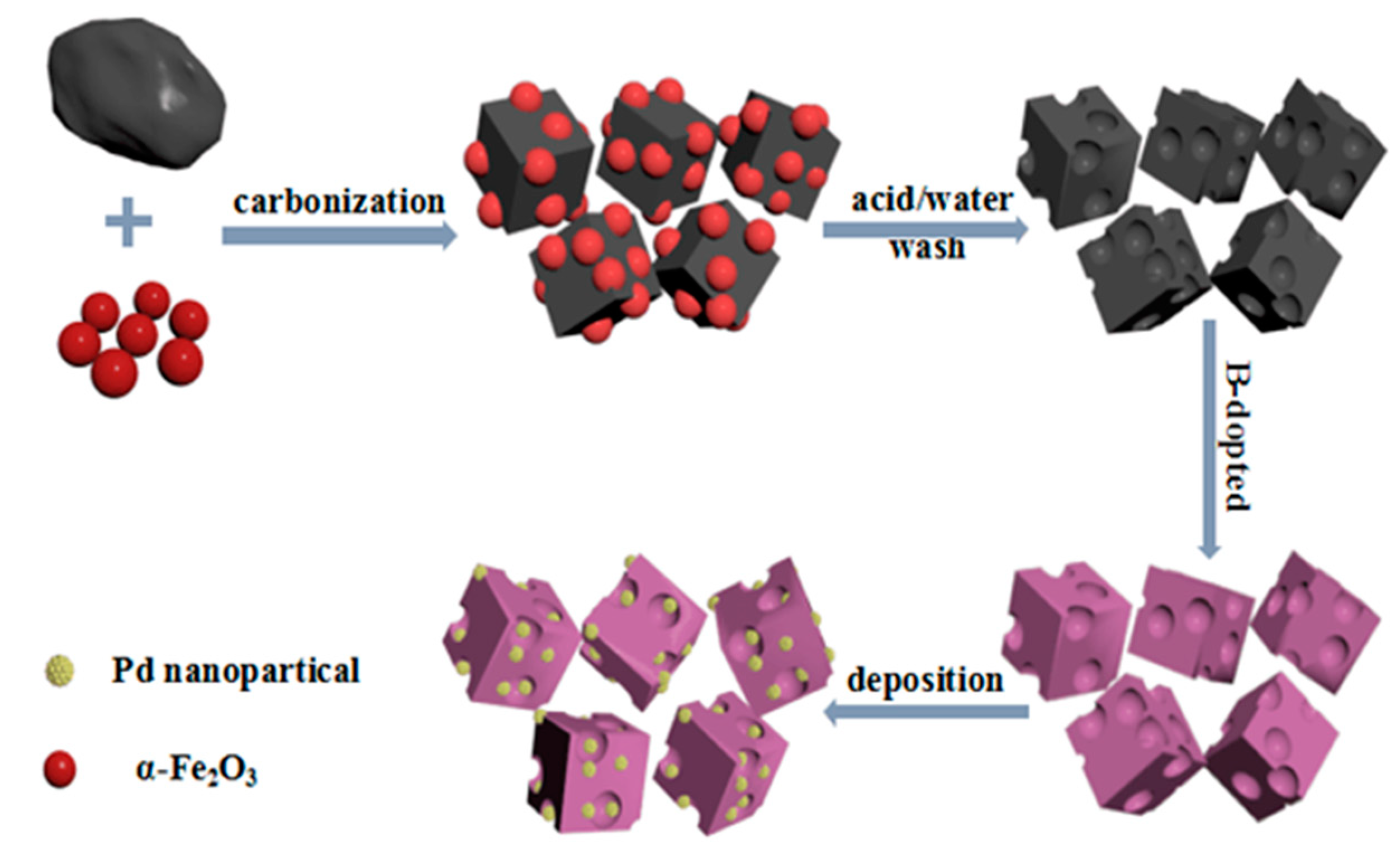
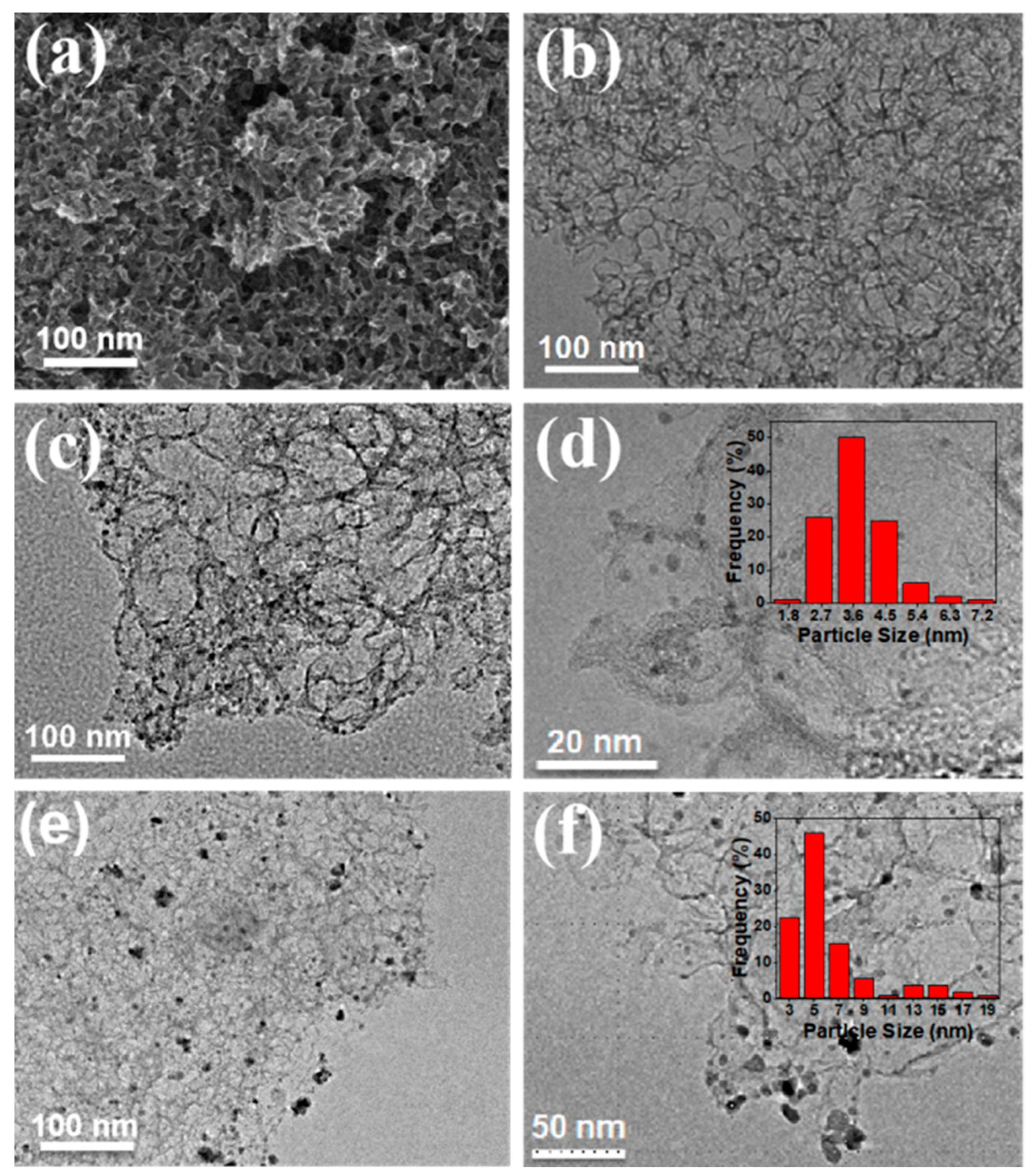
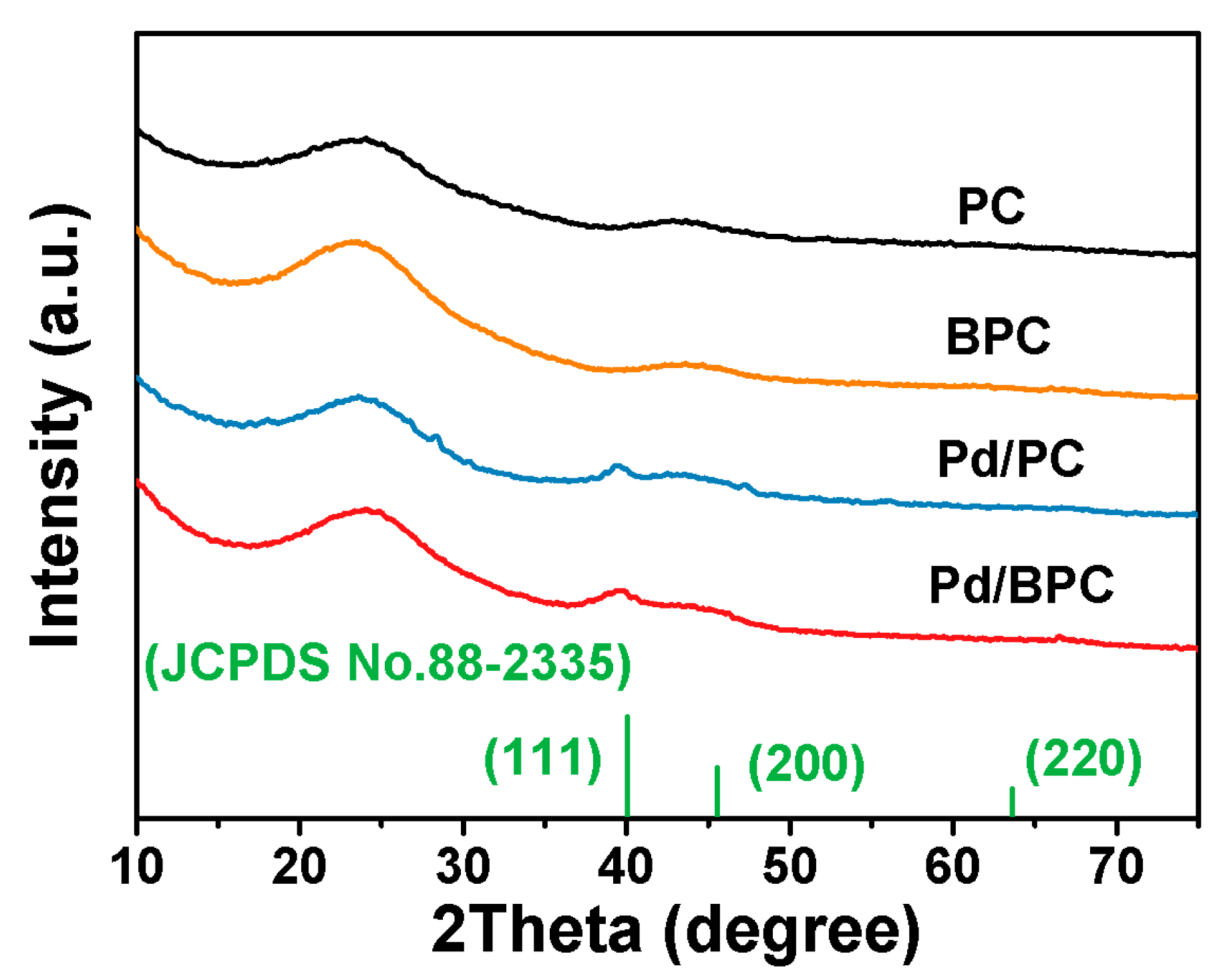
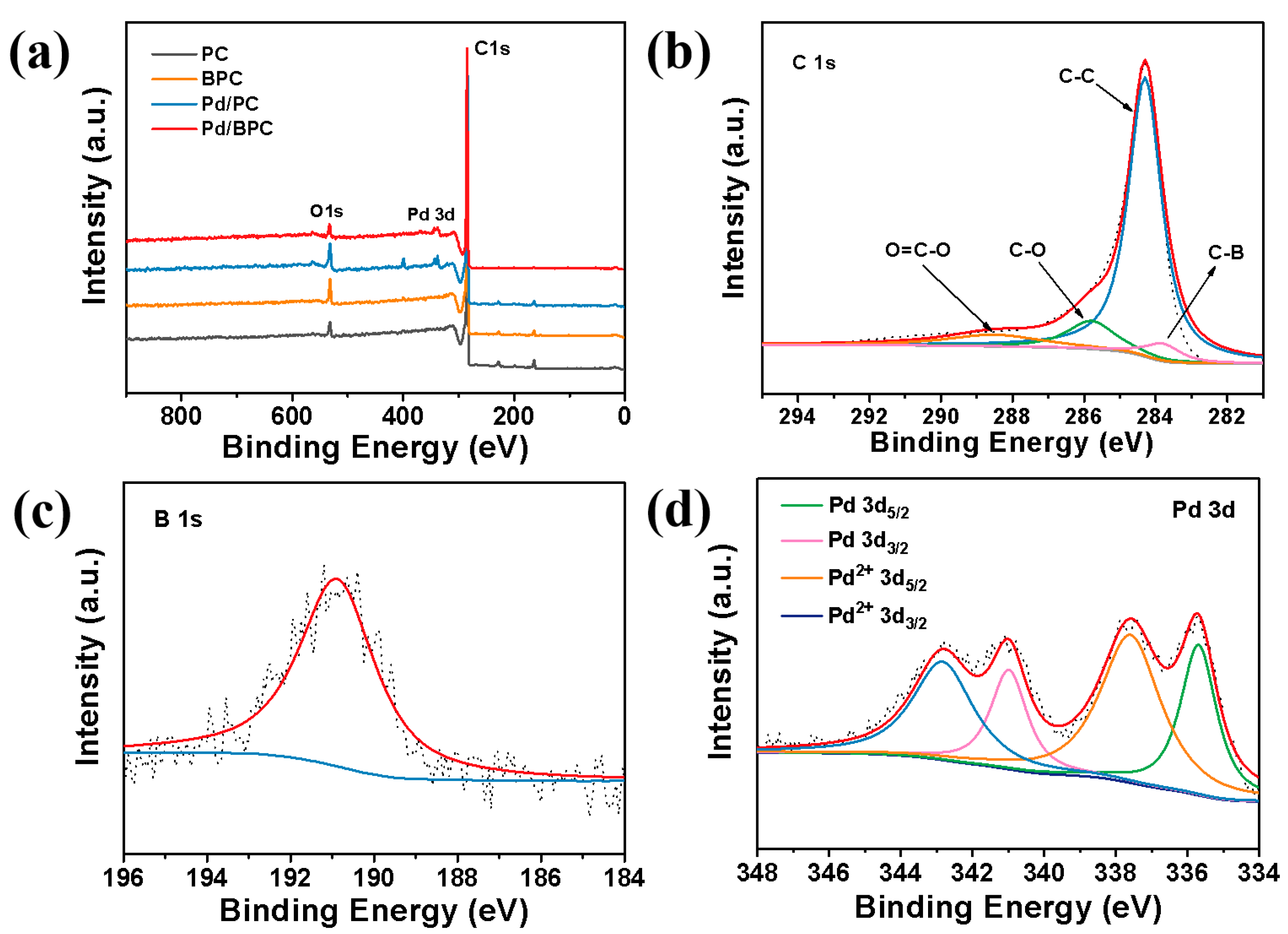
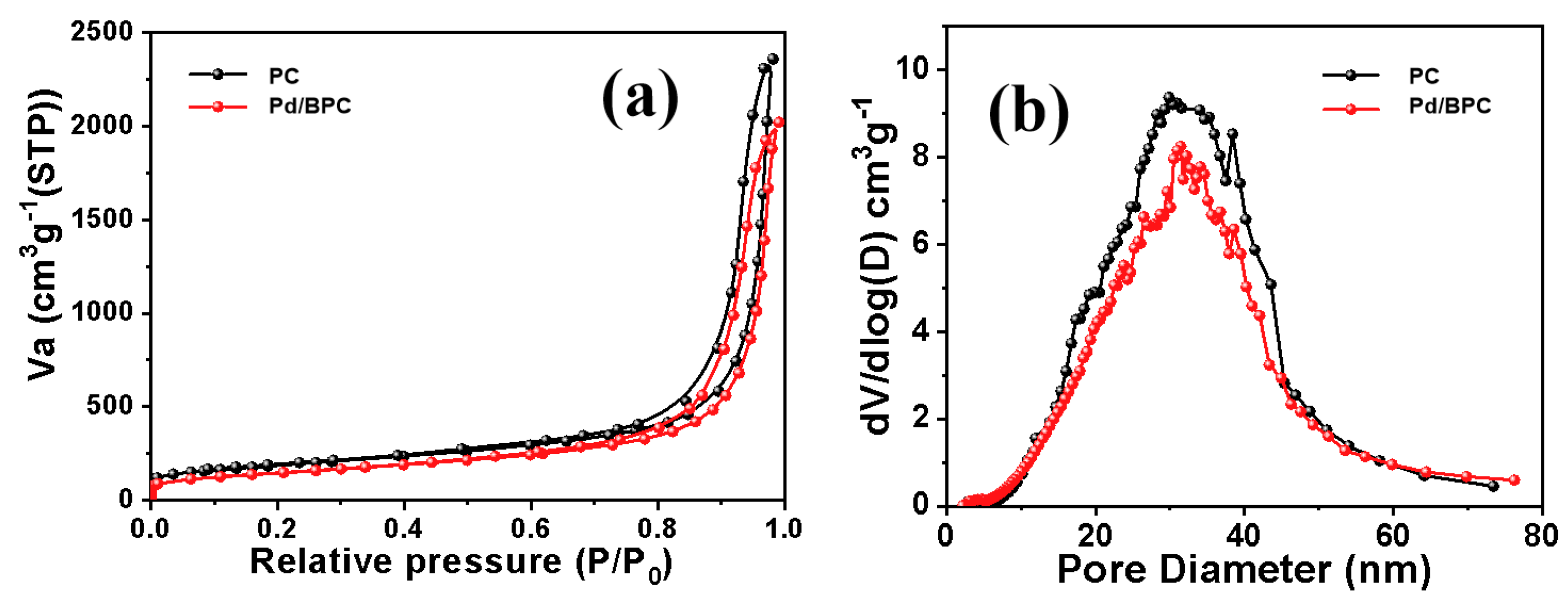
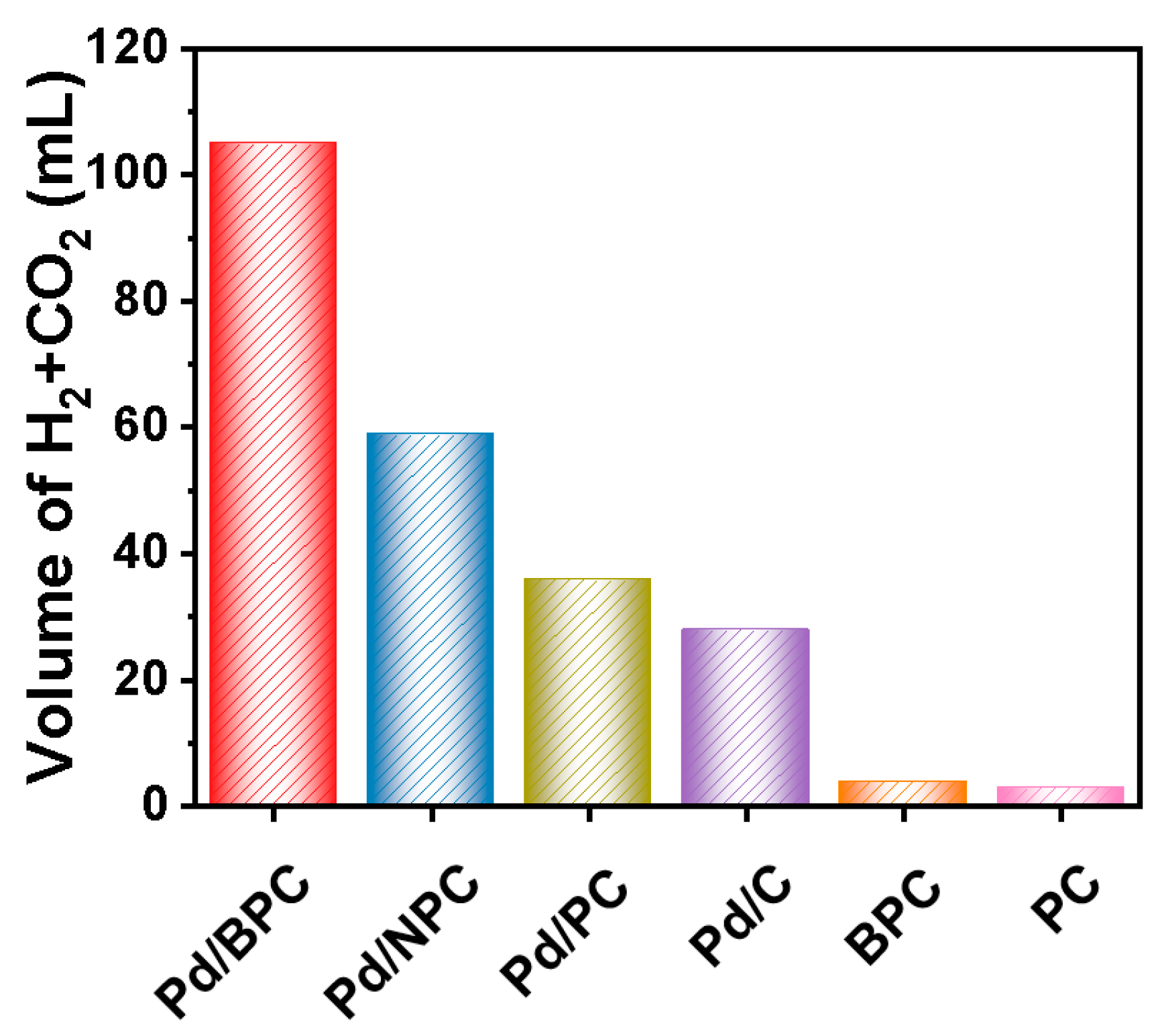


Disclaimer/Publisher’s Note: The statements, opinions and data contained in all publications are solely those of the individual author(s) and contributor(s) and not of MDPI and/or the editor(s). MDPI and/or the editor(s) disclaim responsibility for any injury to people or property resulting from any ideas, methods, instructions or products referred to in the content. |
© 2024 by the authors. Licensee MDPI, Basel, Switzerland. This article is an open access article distributed under the terms and conditions of the Creative Commons Attribution (CC BY) license (https://creativecommons.org/licenses/by/4.0/).
Share and Cite
Liu, H.; Huang, M.; Tao, W.; Han, L.; Zhang, J.; Zhao, Q. A Palladium Catalyst Supported on Boron-Doped Porous Carbon for Efficient Dehydrogenation of Formic Acid. Nanomaterials 2024, 14, 549. https://doi.org/10.3390/nano14060549
Liu H, Huang M, Tao W, Han L, Zhang J, Zhao Q. A Palladium Catalyst Supported on Boron-Doped Porous Carbon for Efficient Dehydrogenation of Formic Acid. Nanomaterials. 2024; 14(6):549. https://doi.org/10.3390/nano14060549
Chicago/Turabian StyleLiu, Hui, Mengyuan Huang, Wenling Tao, Liangliang Han, Jinqiang Zhang, and Qingshan Zhao. 2024. "A Palladium Catalyst Supported on Boron-Doped Porous Carbon for Efficient Dehydrogenation of Formic Acid" Nanomaterials 14, no. 6: 549. https://doi.org/10.3390/nano14060549





